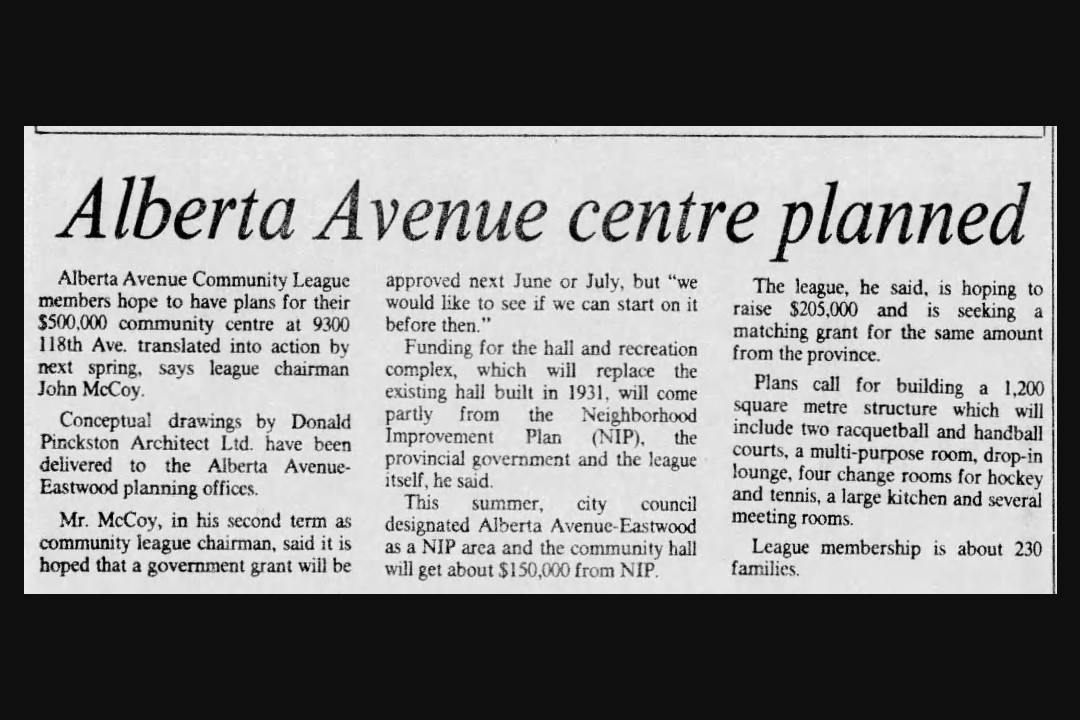On this day in 1979, plans were underway to build a new community centre on Alberta Avenue, one of Edmonton's oldest and most storied streets.
Alberta Avenue's origins date back to 1894, when a few lots were carved out of the bush on the outskirts of Edmonton. It started to go by the name of Norwood and remained mostly isolated. By 1906, it had a handful of residents and a small, three-room school. But in the next few years, two things would lead to explosive growth: meat and coal.
The railway was extended north of Edmonton, and industry started to spring up to take advantage of cheap land and rail access. The aptly named Village of North Edmonton was founded around 1908 in the vicinity of what is now 127 Avenue and 66 Street. The area was known as Packingtown because of the high number of meat-packing plants that opened there.
At the same time, the then-town of Beverly was growing to the west, fuelled by the coal mines dotting the river valley. The city extended its streetcar line to run through Norwood to deal with the increased travel between Edmonton and Beverly. Soon, bakers, grocers, and other business owners set up shop along the streetcar line. At the same time, workers from Packingtown were buying up the land and building homes in Norwood because of the short commute to the packing plants. The main thoroughfare would become Alberta Avenue, although it was officially renamed 118 Avenue in 1914, when Edmonton redid its street-naming system.
The avenue and the communities around it continued to grow. New industries such as the Norwood Foundry appeared. New commercial and retail found space along Alberta Avenue and nearby Norwood Boulevard. And new residents moved in. The Norwood and Alberta Avenue community leagues were both founded in 1922. The 1930s saw the development of more public space and recreational facilities. The Avenue Theatre, one of the street's most well-known buildings, first started screening shows in the 1950s.
The neighbourhood's fortunes, as well as its reputation, declined in the 1970s. Many buildings first constructed in the early part of the century required replacement or repair — including the community league centre.
By this time, the city had grown around the neighbourhood, which was now close to the core. People were moving out to the rapidly expanding edges of the city, leaving empty properties behind. The opening of the Yellowhead in 1984 also had a significant effect on the area. Commuter traffic along the avenue dropped, and businesses along the stretch closed.
Addiction, income inequality, and fear of crime had become major issues for the area. The 1990s saw dropping real estate prices, derelict properties, and increased crime. But it was also a time of community-led revitalization efforts and a focus on making Alberta Avenue a hub for the arts. The community league, businesses, and residents began working on programs and events to support artists living in the area as well as to reduce crime and disrepair.
The city government has also been involved, providing revitalization funds, coordination, and other support to the community. Today, the Alberta Avenue neighbourhood is once again in transformation, as it has been many times in its history. Serious issues remain, including recent concerns over the number of derelict properties. But it is also home to the popular Deep Freeze and Kaleido festivals, the upcoming Eats on 118 celebration, community gathering spots like the Carrot Coffee House, and the programs supported by the Alberta Avenue Community League.
This clipping was found on Vintage Edmonton, a daily look at Edmonton's history from armchair archivist @revRecluse of @VintageEdmonton.

